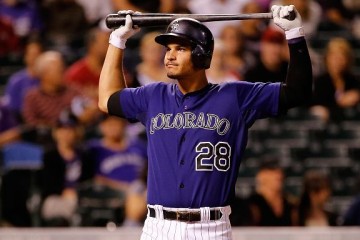2016 Fantasy Baseball: Plate Discipline — Third Basemen

For those that watch baseball religiously, a lot has been made of the so-called five tools that scouts look to when evaluating players. While fielding and throwing are important, they typically don’t matter to fantasy players. Most fantasy players focus on the other three tools: hitting, hitting for power, and speed. That translates into hitting for average, hitting for power, and stealing bases.
More and more leagues are including an on base element. That could be walks or on base percentage. Even leagues that continue to use the standard five categories can take advantage of what some lovingly call the sixth tool (or fourth fantasy tool): plate discipline. As scouts and baseball executives are becoming increasingly aware, players are born with plate discipline or are not.
Essentially, the difference between the hit tool and the plate discipline tool is that with the plate discipline tool you are able to recognize which pitches you should swing at. When looking at the data, the key statistic (as found at Fangraphs) is Oswing. That is the percentage of pitches outside the strike zone that a hitter swings at. Talented hitters can make contact on those pitches, but usually it is the kind of contact pitchers want.
Plate discipline is only one of the four tools that fantasy players look for, so you shouldn’t govern your entire draft based on plate discipline, but it does allow us to find the occasional sleeper and avoid the occasional rotter. In this series, we will identify a couple of sleepers and a couple of players who could end up being busts. Looking at all of the data helps us see why guys strikeout a lot or walk a lot. When we do that, it helps explain why some us end up liking certain guys and not liking others. Often we get criticized for that and we don’t have the words to articulate our feelings. Some of these numbers give us that articulation.
Sleepers
| SO% | BB% | Oswing | Zcontact | Contact | BABIP | |
| 2013 | 17.5 | 7.9 | 20.5 | 95.1 | 87.6 | .307 |
| 2014 | 15.2 | 8.5 | 23.7 | 93.3 | 87.1 | .314 |
| 2015 | 19.7 | 10.1 | 19.3 | 89.0 | 85.8 | .321 |
ESPN.com has Anthony Rendon rated ninth among third basemen and 95th overall. Yahoo ranks Rendon tenth among third basemen and 101st overall. So, while it would seem foolish to label Rendon as a sleeper at first glance, we can see that third base is actually a pretty deep position overall. As you might suspect, Rendon’s problems have little to do with what happens when he’s at the plate. The problem with Rendon has been his ability to remain on the field.
That being said, his Oswing rate was tops among third basemen with 300 or more plate appearances last season and while his rate was slightly better than his career average, he might just have the best plate discipline in baseball. It’s good enough to make him a top five fantasy third basemen if he can bring it all together.
| SO% | BB% | Oswing | Zcontact | Contact | BABIP | |
| 2013 | 16.1 | 13.6 | 24.6 | 91.1 | 83.5 | .233 |
| 2014 | 20.7 | 11.9 | 27.6 | 86.6 | 78.3 | .294 |
| 2015 | 21.5 | 10.1 | 28.0 | 83.9 | 77.2 | .235 |
There are sleepers and then there are hibernators. Valbuena belongs in the second category. Still, he is eligible at first and third and has averaged more than 500 plate appearances the last two seasons. The power numbers have increased in each of the past few seasons and the BABIP shows there are tons of room for improvement. Add 60 points to his average and suddenly you are looking at a .280 hitter.
Valbuena is a pure example of the difference between process and results. Results are what they are, but it is easy to misinterpret them. You look at Valbuena and see a guy that swings and misses a lot. He must be a free swinger. The Oswing rates are better than average and Valbuena was among the leaders in the number of pitches seen per plate appearance. Add it all up and you get a guy capable of hitting better than .250 with 20 or more home runs. It’s not great, but it could be a lot worse.
Rotters
| SO% | BB% | Oswing | Zcontact | Contact | BABIP | |
| 2013 | 14.0 | 4.5 | 41.0 | 88.0 | 82.2 | .296 |
| 2014 | 12.4 | 5.4 | 38.6 | 89.4 | 84.7 | .294 |
| 2015 | 16.5 | 5.1 | 39.9 | 90.9 | 80.2 | .284 |
We move from one extreme to the other. Arenado is rated as the second best third basemen according to most projection systems. We don’t want to rain on his parade because plate discipline is only part of the puzzle. Yet, looking at the differences between Arenado and Valbuena (or Rendon) demonstrate the need to add a sixth tool to the tool box. Arenado certainly has a well developed hit tool and he certainly has power, but we have to wonder if the lack of discipline will catch up with him.
2016 will tell the tale in a number of ways. He has proven that he is willing to fish on pitches outside the zone. Last season he finally capitalized on his power potential, so pitchers are going to be a lot more careful around him in the future. He could be a serious regression candidate if he doesn’t learn to lay off waste pitches.
| SO% | BB% | Oswing | Zcontact | Contact | BABIP | |
| 2013 | 20.8 | 8.3 | 33.7 | 84.7 | 76.4 | .269 |
| 2014 | 21.1 | 7.9 | 33.7 | 83.4 | 74.9 | .309 |
| 2015 | 20.2 | 6.5 | 37.8 | 85.2 | 76.7 | .271 |
Frazier is a popular sleeper candidate because he is switching teams. It makes perfect sense when you look at the basic numbers. His power numbers have been increasing, he’s moving to a new team with a better offense, and even his BABIP predicts an upswing. However, the plate discipline demonstrates something else. His dwindling walk rate is pretty troubling. Again, plate discipline is only one of the factors involved in picking a player. Still, maybe we shouldn’t be so bullish on Frazier.





